A yeogwan may represent a night’s rest sleeping on a heated floor or a reminder of extraordinary hardships during turbulent times. These old-fashioned cousins of the modern hotel that arrived some 150 years ago also cradled the imagination and creativity of artists, poets and writers. The sites of yeogwan with a particularly rich history still remain, recalling their heyday.
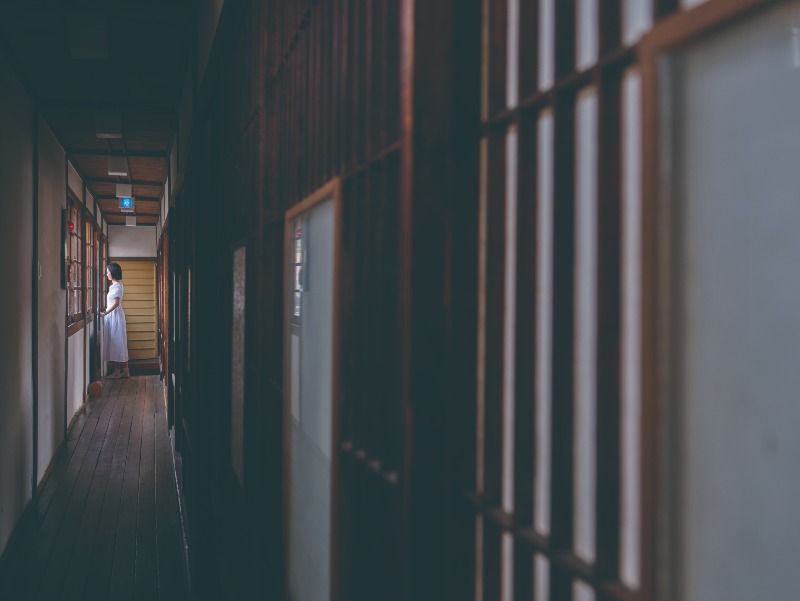
The second-floor hallway of Boseong Yeogwan, a Registered Cultural Heritage of Korea. The hotel is one of the major settings in “Taebaek Mountain Range” (Taebaek sanmaek), an epic novel by Jo Jung-rae.
Yeogwan, Korea’s first modern-style accommodation for travelers, began to appear when the country opened its ports in 1876. One by one, these establishments opened near Busan, Wonsan and Incheon, most under Japanese ownership and catering primarily to visitors from Japan. About 20 years later, Koreans entered the hospitality business, and in the 1900s, yeogwan started to appear in Seoul. Their number increased during the Japanese colonial period (1910-1945), mainly in cities with advanced transportation and communication infrastructure or at popular tourist sites.
In the early days, most yeogwan offered both lodging and food. By the 1920s, they had evolved to the point that some popular yeogwan in Seoul even equipped each of their rooms with the communication marvel of that time: a telephone. Today, yeogwan are considered a step below a motel; rather than offering a bed and some amenities, they are lower in price and generally provide a room with a heated floor (ondol) and mats for sleeping on the floor. But in those earlier times, as yeogwan accommodated overnight and extended visits, relationships formed among the long-term guests, and the trappings of the hotels served as a backdrop for works of art and literature.
Poets’ Haven
In November 1936, the first issue of the coterie magazine “Poets’ Village” (Siin burak) was published. The magazine did not carry the banner for any particular literary ideology or orientation, and attracted hardly any attention in literary circles because it was discontinued just one month later, after the second issue. However, the magazine’s significance in literary history was reevaluated after its contributors, including Kim Tong-ni (Kim Dong-ri), Yu Chi-hwan and Kim Gwang-gyun, emerged as central figures in Korean literature. These poets were keen on exploring the human mind and life force, and less concerned with devising refined techniques and styles. They collectively became known as the “life school” (saengmyeongpa).
The editor and publisher of the magazine’s first issue was So Chong-ju (Seo Jeong-ju; 1915-2000), a 21-year-old poet and student at Jung-Ang Buddhist College (present-day Dongguk University). In the editor’s comments, he wrote, “We agreed to endeavor to build a poets’ village on a site where the sun shines brightly. A young, vibrant place with a sweeping view of the distant past at the back and the far future ahead of us…”
This passage reveals the confidence and enthusiasm of the young poets. The copyright page at the end of the first issue provided information about the publication, including the names of the editor and publisher, the printer, the printing house, the publishing office, the number of pages and the price. The publisher’s address was No. 3 Tongui-dong, the location of Boan Yeogwan, where So was staying at the time. While he wrote poems and worked on the coterie magazine, So took an extended stay at the hotel, which is presumed to have been built in the early 1930s. Many would-be writers flocking to Seoul from the provinces supposedly followed in So’s footsteps and stayed at Boan Yeogwan while they tried to realize their own dreams of being a writer.
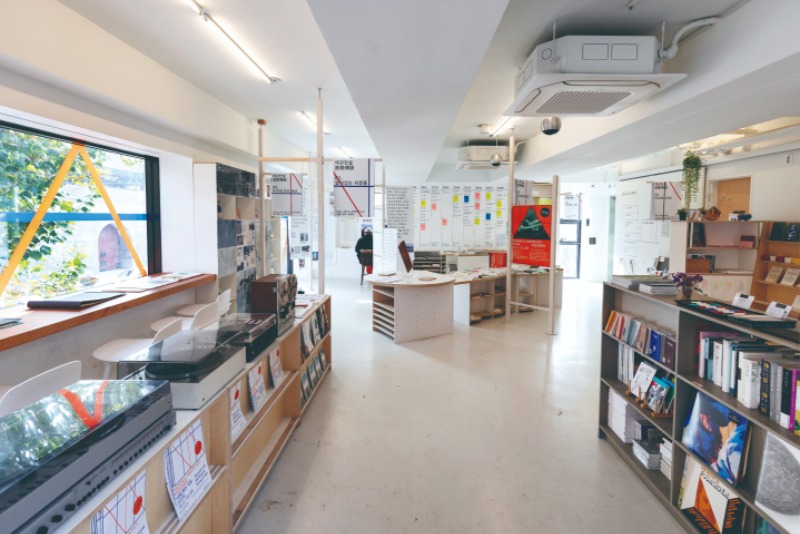
Boan Bookstore on the second floor of the new annex beside Boan Yeogwan. Presumably built in the early 1930s, the historic building is where poet So Chong-ju had a lengthy stay, writing poems and planning to publish a coterie magazine.
© Everyday Practice
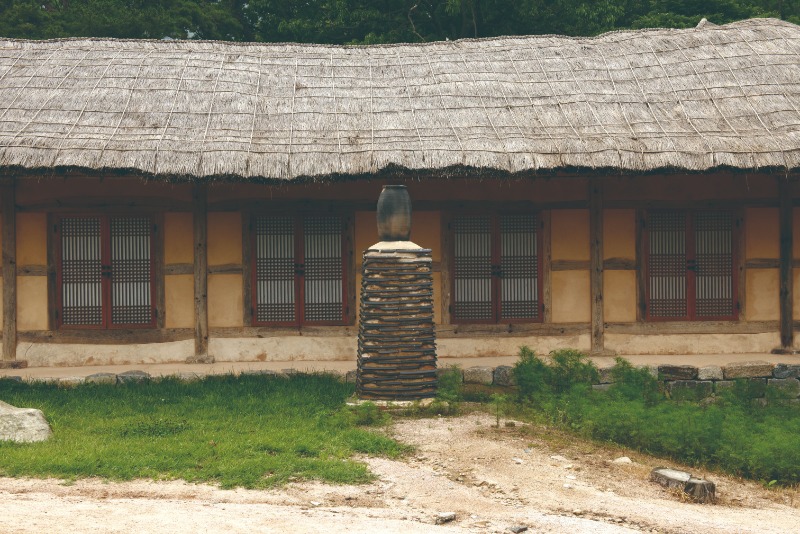
Sudeok Yeogwan, a thatched house with an open square layout, was a temporary abode for writer and painter Na Hye-seok. Later, it was purchased by artist Lee Ung-no, who used it as a means to cover living expenses and as an atelier.
© gettyimagesKOREA
The site of Boan Yeogwan faced Yeongchu Gate of Gyeongbok Palace, which is on the road that later became a route to Cheong Wa Dae, the presidential office. During the nationwide night curfew of the 1970s and early 1980s, presidential staff often used Boan Yeogwan when it was too late to go home. Meanwhile, the security forces for Cheong Wa Dae used nearby Gyeongbok Palace as their base. This made Boan an equally popular choice among the soldiers’ visiting friends and families, who came from all over the country. It is said that the smell of roast chicken filled the place when it was crowded with the soldiers and their visitors. Later, through the early 1980s, when the National Museum of Korea was still located on the grounds of Gyeongbok Palace, Boan proved useful to museum staff who would sleep there after working late to prepare for exhibitions.
Boan Yeogwan closed after decades of service, but the building still stands. The signboard, with its blue letters on a white background, is old-fashioned, featuring the familiar wavy steam icon that indicates a public bath. The building was taken over by Ilmaek Cultural Foundation and turned into a gallery. In 2017, it was then renovated into a cultural complex called Boan 1942, with a café, bookstore and other project spaces. Today, it is a landmark of the Seochon area.
Inside Boan, the ceiling has been removed toan austere environment for artistic effect, with exposed wooden beams and columns, and some of the walls torn down. The wooden members look as if they’re floating in the air, entangled electric wires and insulators run along the exposed ceiling, and the faded old wallpaper is torn here and there, revealing yellow mud crumbling beneath it. On the ridge beam are the words written for the roof-raising ceremony during the Japanese colonial period. Outside the window, an attractive view of the royal palace stretches beyond Yeongchu Gate.
Three-storied Yeogwan
Sudeok Temple is an old Buddhist sanctuary in Yesan, South Chungcheong Province. Established during the late Baekje Kingdom (18 BCE-660), the temple is famous for its main hall (Daeungjeon), built in 1308 during the Goryeo Dynasty. Designated as a National Treasure, the main hall is one of the oldest wooden buildings in the country. Just outside the gate at the temple’s entrance is Sudeok Yeogwan, boasting a history saturated with stories about esteemed artists of bygone days.
Toward the end of 1937, writer and painter Na Hye-seok (1896-1948) went to Sudeok Temple to meet her friend Kim Il-yeob (1896-1971), who had become a Buddhist nun a few years earlier. Na wanted to ask Kim to help her to become a nun as well. The two friends had a lot in common besides their age; both of them grew up in artistic families who embraced enlightened ideas. They had met and become friends while studying in Japan. Later, they became paragons of the “new woman,” voicing gender equality and free love, radical notions in their time.
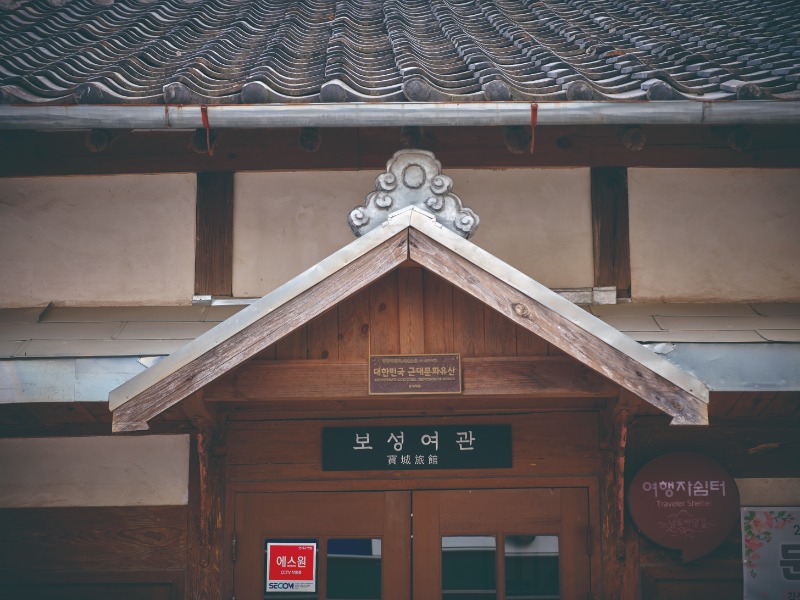
Boseong Yeogwan played a key role in the history and culture of Beolgyo during the modern and contemporary period. In recognition of its stature, it was designated a Registered Cultural Property in 2004.
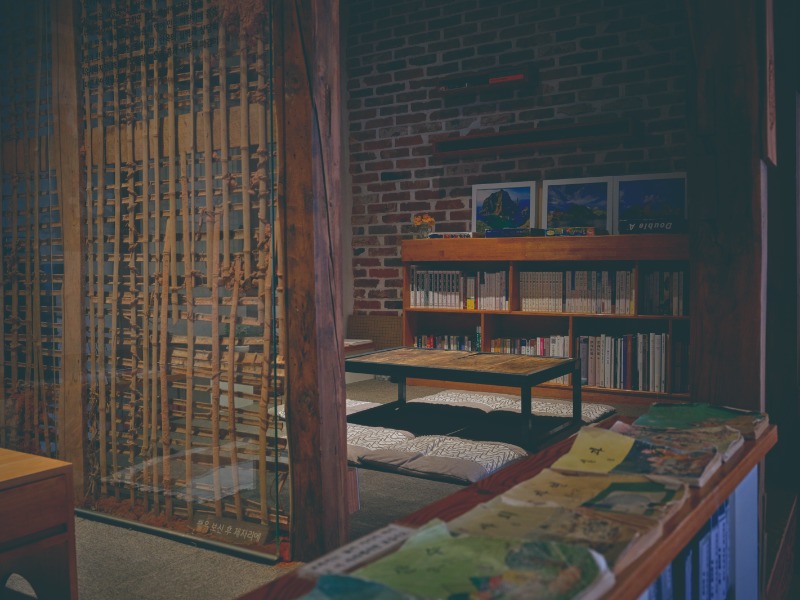
A display of old textbooks and children’s books in the café on the first floor of Boseong Yeogwan stirs up memories of the past.
After a series of failed relationships, Kim took shelter at the Buddhist monastery in 1928 and became a nun in 1933. Frustrated by the restraints that patriarchy imposed upon women, Na also decided to renounce the world. She asked her friend Kim to persuade Monk Mangong (1871-1946) to accept her into the monastery, but the monk flatly refused, saying, “You’re not suited for a religious life.”
Uncertain as to her future direction in life, Na stayed for a while at Sudeok Yeogwan just outside the temple. Though she suffered all sorts of hardships, she continued to paint and teach would-be artists. She also visited Haein Temple in Hapcheon and painted a landscape of the surroundings, which she supposedly gave to the owner of Hongdo Yeogwan, located near the entrance of the temple. After leaving the two temples and her temporary stays in the two yeogwan, Na led a nomadic life until she died alone in 1948 in a hospital in Yongsan, Seoul, her identity unknown. Kim Il-yeob died at Sudeok Temple in 1971.
During her stay at Sudeok Yeogwan, Na met artist Lee Ung-no (1904-1989). As he listened to Na talk about art and the world, Lee developed a romantic yearning for Paris. To secure a livelihood, he later purchased Sudeok Yeogwan whose spacious rooms were particularly suitable for use as ateliers.
After Korea’s liberation from Japanese colonial rule in 1945, Lee lived in Seoul. But when the Korean War erupted in 1950, he sought refuge back at Sudeok Yeogwan. Lee left a series of ideographic carvings on the broad, flat rocks in the hotel courtyard. With his ceaseless experimental crossovers into varied genres and subjects, Lee is recognized as a groundbreaker in the history of Korean art. His ideographic sculptures, which he started to make in the early 1960s, had a lyrical quality at first, but gradually evolved into three-dimensional and geometrical combinations. The carvings on the rocks of Sudeok Yeogwan reflect the flow of his experimentation.
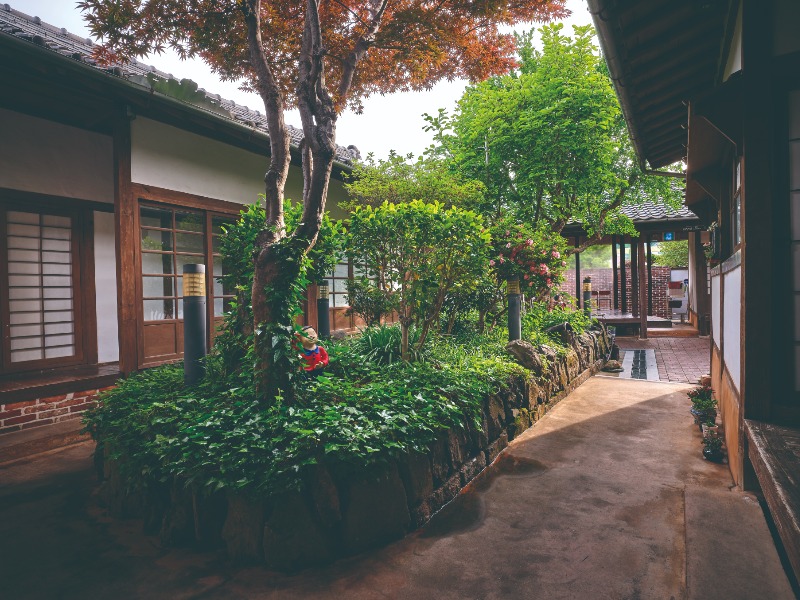
To accommodate guests, the traditional Korean house at the back of Boseong Yeogwan has seven rooms with ondol underfloor heating.
In Literature
Jo Jung-rae (Jo Jeong-rae) made his literary debut in 1970. His epic novel “Taebaek Mountain Range” (Taebaek sanmaek) is considered to be a masterpiece of modern Korean literature. First serialized in a literary magazine in 1983, the novel was eventually published in 10 volumes from 1986 through 1989. The novel is a dramatic portrayal of ordinary people and their lives from 1948 to 1953, as they struggled to survive ideological conflicts and the Korean War.
The third volume contains this passage: “How dare you sleep and eat in a yeogwan at a time like this – you, a punitive force with a mission to suppress the insurgency and handle public unrest?” In the novel, the place where the chief of police and his subordinates stay is named Namdo Yeogwan. It was modeled after Boseong Yeogwan, in the heart of Beolgyo in Boseong County, South Jeolla Province.
Boseong Yeogwan opened its doors in 1935, when Beolgyo, situated on the southern coast, prospered as a transportation hub during the colonial era. Its docks were filled with boats, and Japanese came and went in numbers, boosting commerce in the region. The town brimmed with money and people, as well as gangs. Hence the saying, “Never show off your money or your fists in Beolgyo.” Along with the local train station, Boseong Yeogwan served as a community center and was frequented by many people. It stopped operating in 1988 and was briefly used as a store.
Jo Jung-rae was born in Suncheon in the vicinity of Beolgyo. In the novel, based on the tragic conflicts that occurred in his hometown and the surrounding area, Jo red various familiar places. When the novel became a bestseller, calls mounted for conservation and utilization of Boseong Yeogwan. Accordingly, it was designated as Registered Cultural Property in 2004, and then purchased by the Cultural Heritage Administration of Korea in 2008, which reopened it as a cultural complex in 2012 after repairs and restoration. Consisting of a gallery, theater, café and other entertainment and accommodation facilities, it is now a popular tourist attraction.